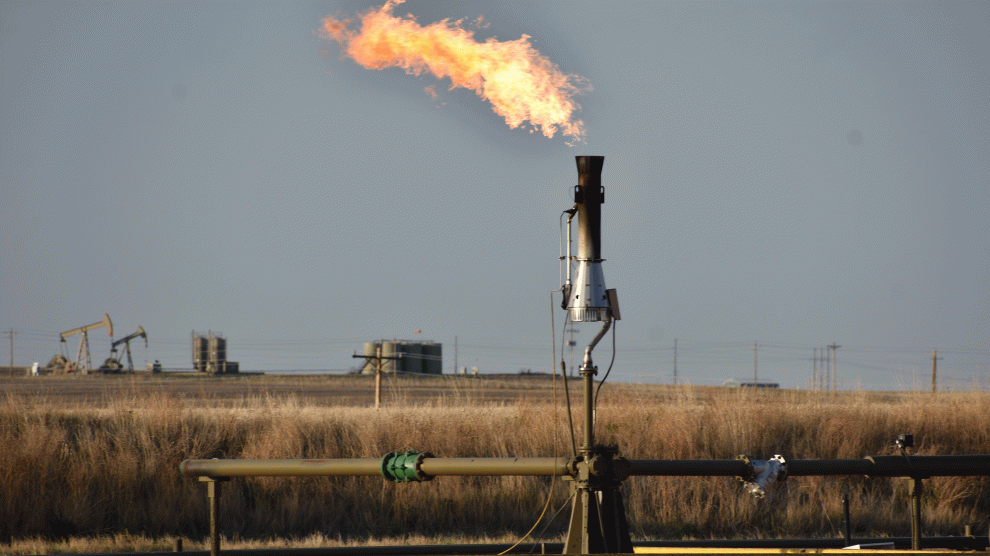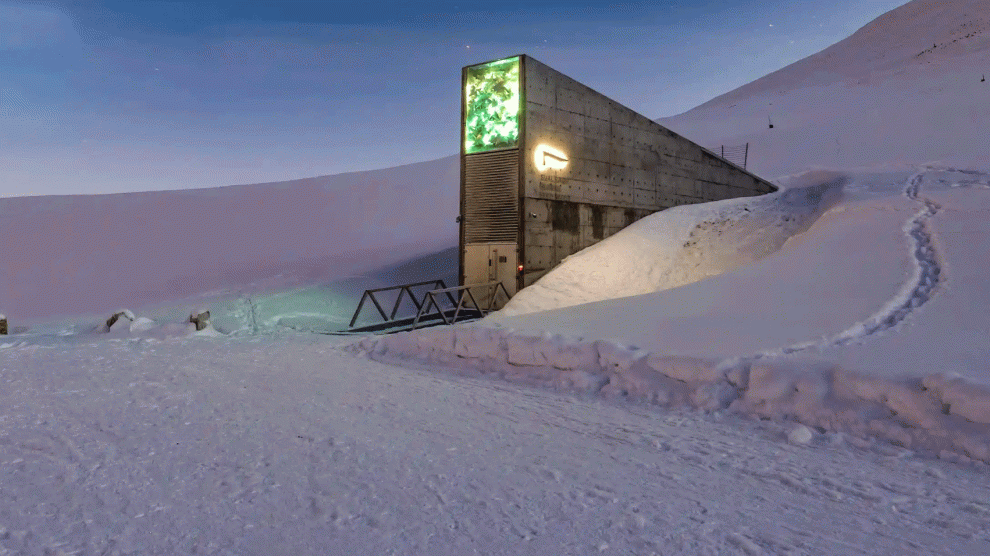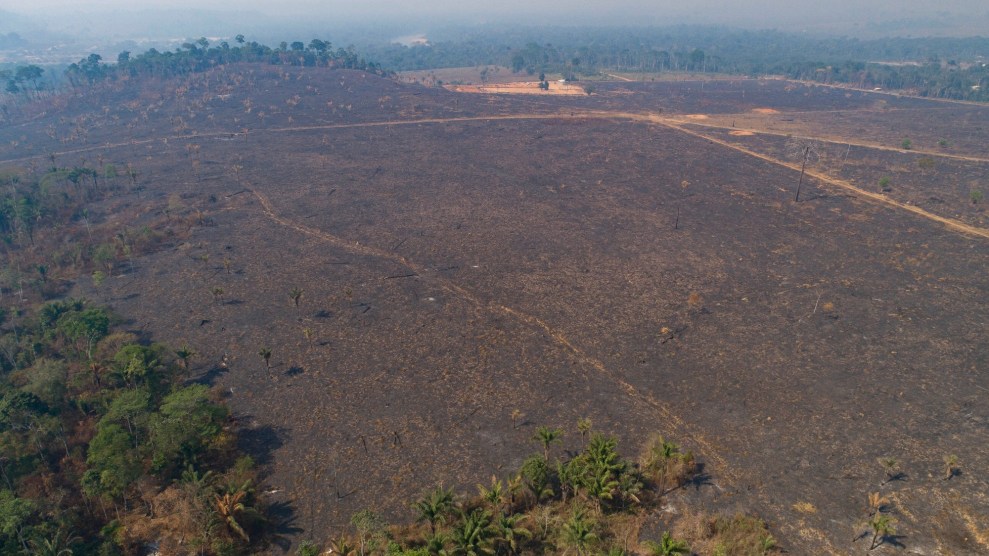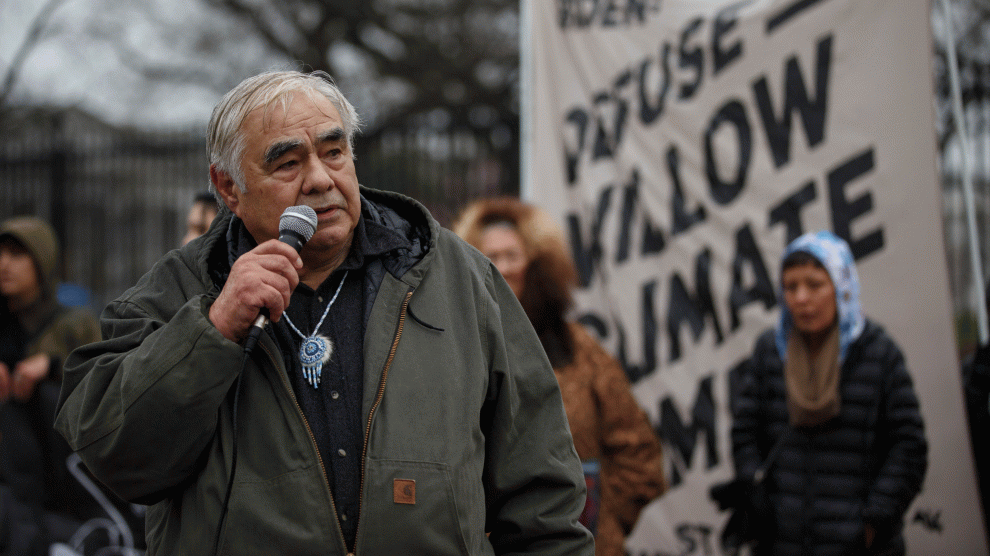
Inupiat wildlife guide Robert Thompson speaks at a protest near the White House on March 3, 2023.Bryan Olin Dozier/NurPhoto/AP
This story was originally published by Inside Climate News and is reproduced here as part of the Climate Desk collaboration.
Environmental and Indigenous activists rallied outside the White House last Friday, calling on President Joe Biden to reject a major Arctic oil project that has been in development for years. The Biden administration is expected to make a final decision on the proposal as soon as next week, and environmental groups have been framing it as a major climate test for the president.
On a rainy, chilly afternoon, about 50 people huddled under a colorful canopy of umbrellas holding banners and appealing to Biden to stand by his campaign promise to help phase out fossil fuels.
The Willow Project, proposed by ConocoPhillips, would be the largest single oil development to proceed under the Biden administration if it is approved. The project would pump more than 600 million barrels of oil over 30 years from a rapidly warming Arctic region, and environmental groups say it is wholly inconsistent with the administration’s climate goals.
“The biggest message we’re sending out loud today is that now is the time for the Biden administration to lead us into a just transition off of fossil fuels and into a more regenerative economy,” said Karlin Nageak Itchoak, senior regional director for The Wilderness Society’s Arctic region.
Itchoak said that Biden must ask himself if he wants to be known as the president who put America on a path toward stopping climate change, or for helping ConocoPhillips at the expense of Indigenous communities and the rest of the world: “The only responsible action here for President Biden is to cancel Willow.”
Siqiniq Maupin, executive director of the Sovereign Iñupiat for a Living Arctic, a group representing Indigenous Arctic communities, said the project would have a devastating impact on Native communities and would worsen climate change. “We want to encourage [Biden] to listen to the voices that are the most affected,” Maupin said. “We will continue to support him if he stops the Willow Project.”
The Native village that lies closest to the project is also opposed. In comments to the Interior Department, representatives of Nuiqsut have warned that Willow’s construction would disrupt the migration of the caribou that residents depend on for food and that pollution from drilling could harm villagers’ health.
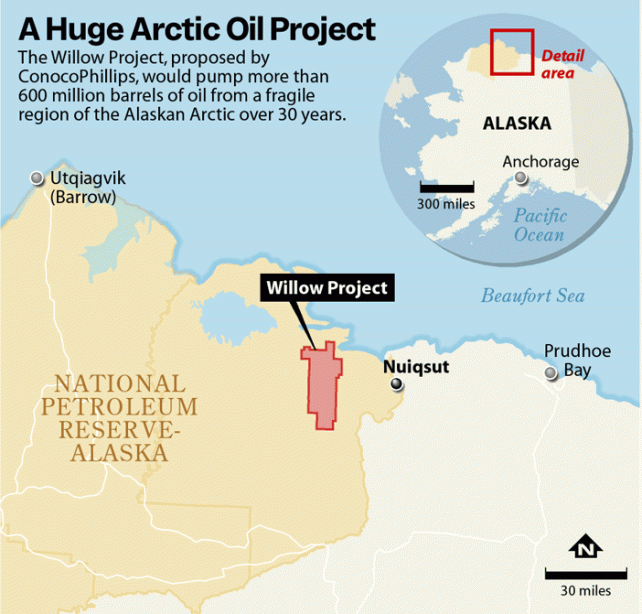
Sources: Interior Department, BLM, Department of Natural Resources
Paul Horn/ICN
Supporters, including Alaska’s entire Congressional delegation and the leaders of several other Native villages, say Willow would be a boon to the state’s ailing economy, providing billions of dollars to the state and local governments.
Nagruk Harcharek, president of the Voice of the Arctic Iñupiat, which represents two dozen native communities, corporations and local governments on the North Slope, said outside interests were drowning out those who live in the region and support Willow.
“We know our ancestral homeland and communities better than anyone,” Harcharek said in a statement. “And we know that resource development and our subsistence way of life are not mutually exclusive. We urge the Biden administration to embrace our perspective and advance a Record of Decision on Willow.”
President Joe Biden has come under immense pressure in recent weeks from both sides. Alaska’s state legislature unanimously passed a resolution this week calling for the project’s approval. The head of the state chapter of the AFL-CIO also published an op-ed last week in support of the project. Sen. Lisa Murkowski, a moderate Republican who has helped Biden advance nominees through the Senate, has also made clear that she expects the administration to approve Willow.
ConocoPhillips spent $8.7 million lobbying Congress and the Biden administration last year, more than it had spent over the previous two years combined, according to OpenSecrets, which tracks money in politics. The company is also a top donor to Murkowski: It gave her campaign and political action committee $61,600 in the most recent election cycle, according to OpenSecrets.
Meanwhile, a petition on the website Change.org calling on Biden to reject the Willow Project had gathered more than 2.4 million signatures as of Friday afternoon. Activists said that was the most signatures a petition on the site had garnered in years.
Multiple press reports this week said White House officials were offering environmental groups a deal of sorts, either by approving a more limited version of the project or by expanding environmental protections elsewhere in Alaska in exchange for approving oil drilling. Environmentalists, however, have been steadfast in their opposition to the project.
ConocoPhillips, meanwhile, has said that further limiting Willow’s scale could make the project no longer economically viable. Murkowski and other supporters have said they would consider a more limited approval by the administration to be effectively a rejection.
ConocoPhillips spokesperson Dennis Nuss said in an email that “Willow has undergone a comprehensive regulatory process for nearly five years with extensive public input, and Alaska Native communities on the North Slope have repeatedly voiced their support for the project.” The White House did not immediately respond to requests for comment.
Willow would advance oil companies’ westward march across Alaska’s North Slope and press drilling deeper into Alaska’s National Petroleum Reserve, 23 million acres of tundra that was set aside in 1923 as an emergency supply of oil for the Navy and is managed by the Bureau of Land Management, which is part of the Interior Department.
Last month, the bureau published a final environmental impact statement for the project that recommended approval of a slightly scaled-down version from what ConocoPhillips had proposed. This “preferred alternative” would include only three drilling locations, containing more than 200 wells, with the possibility of adding a fourth. ConocoPhillips had proposed drilling from five locations.
While the alternative would shrink the surface impacts of the project, ConocoPhillips would still be able to access nearly all the oil it is seeking. Over the 30-year life of the project, that would mean the release of about 280 million metric tons of climate pollution, about the same as running 2.5 coal plants for that entire period.
After the bureau published its recommendation, the Interior Department issued a statement saying it had “substantial concerns about the Willow project and the preferred alternative as presented” in the environmental statement, “including direct and indirect greenhouse gas emissions and impacts to wildlife and Alaska Native subsistence.” It added that the final decision could reject the project outright or further reduce the number of drilling sites.
The Alaskan Arctic has been warming at about double the global rate, according to the environmental impact statement. Snow is melting earlier. The extent of the sea ice has shrunk.
There is already extensive oil development to the east of where Willow would be located, but the new drilling would extend into the habitat of the Teshekpuk Caribou Herd, a key source of sustenance for the nearby village of Nuiqsut. The project would consume about 500 acres of the animals’ habitat with its roads, pipelines and well pads, according to the environmental impact statement.
In the early years of development, those roads would carry dozens of vehicles per hour for much of the year. The total disturbance from the project would extend across 100,000 acres, the document said, an area through which about 15 percent of the herd passes during its fall migration, and is close to high-density calving grounds.
The proposed three-drilling-site version of the project was developed with the support of the Kuukpik Corporation, the Native corporation in Nuiqsut, which lies about 27 miles away from where the closest well pad would be placed. The corporation has companies that can benefit from oil development and provides dividends to Native shareholders.
In comments submitted to the bureau last year, Kuukpik wrote that it had “struggled to get comfortable with the Project” since it was introduced in 2018, and that some impacts to Native peoples’ way of life would be unavoidable. But it added that it has “always believed that, if carried out responsibly, the Project could bring much-needed benefits to the community, the Borough, and the State of Alaska,” and it supported Willow as long as it was limited to no more than three drilling sites.
